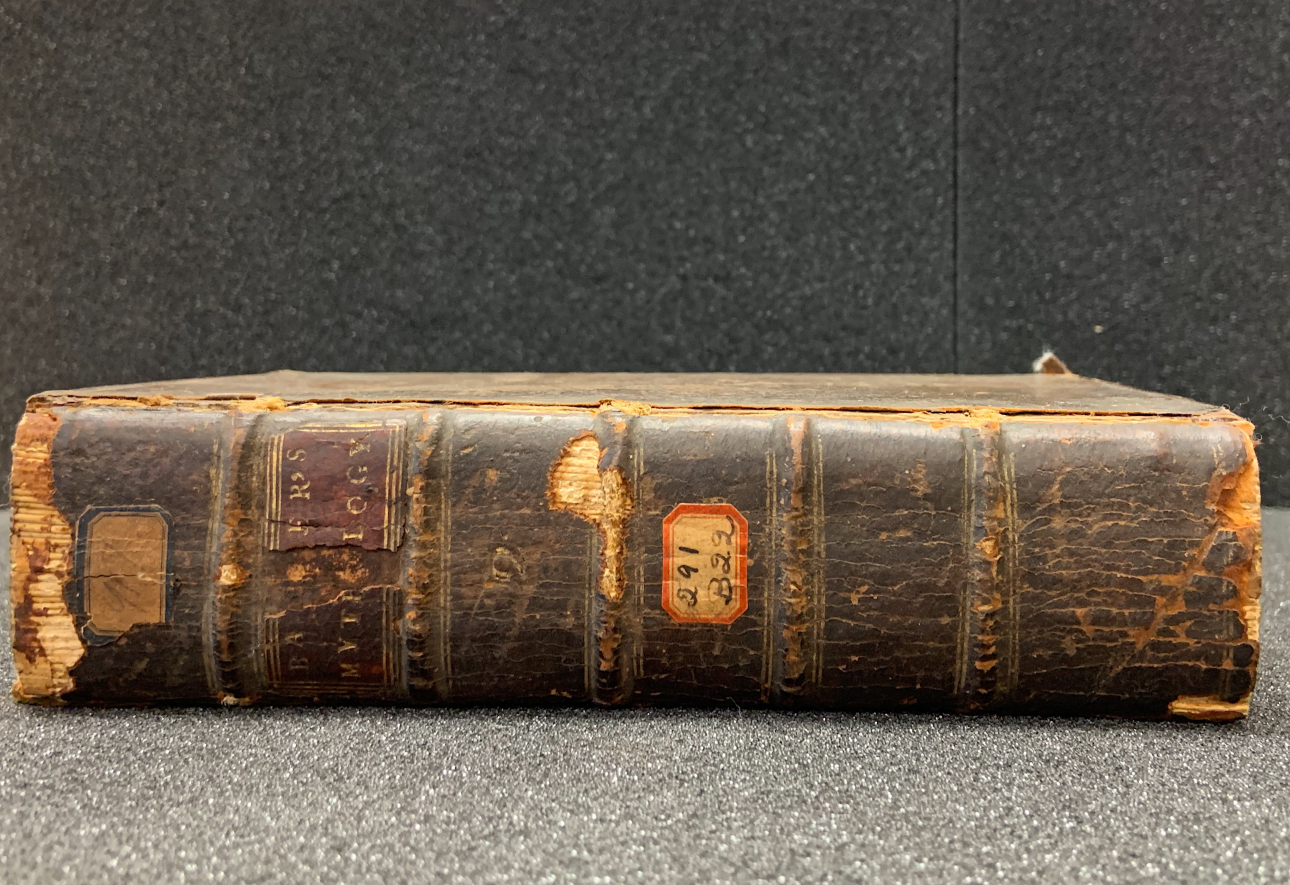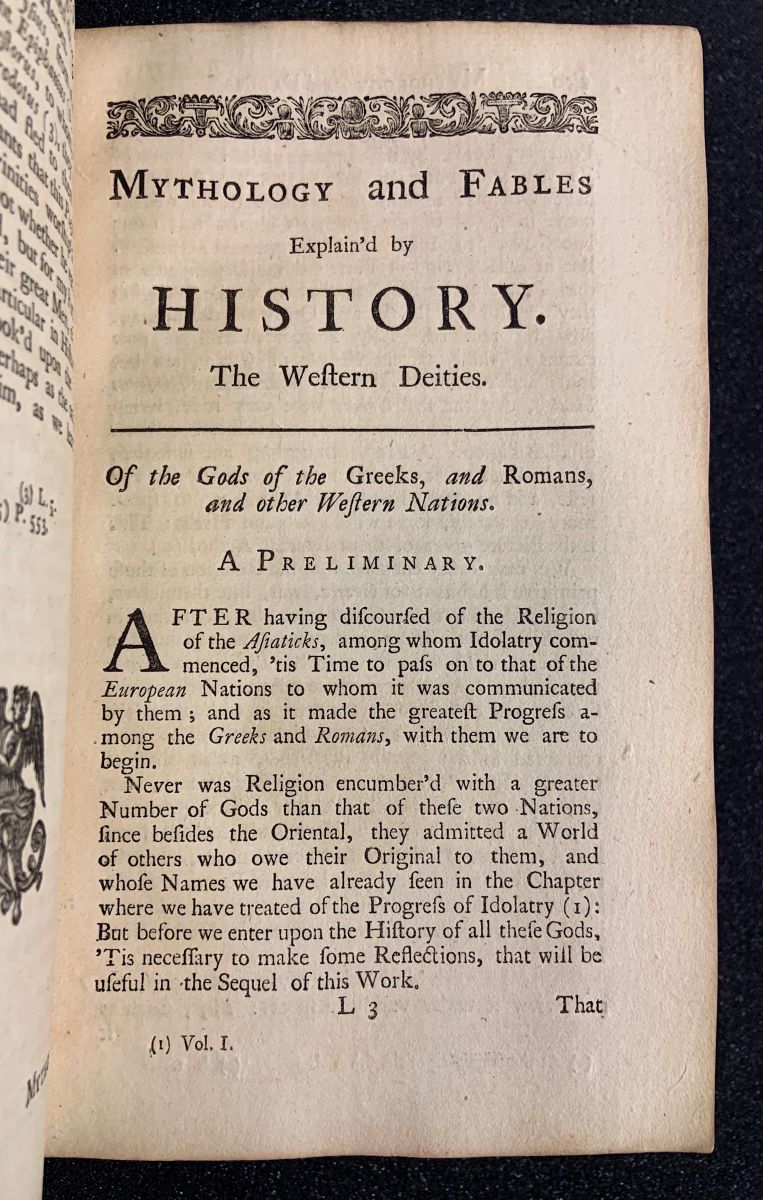This summer we're publishing a series of blog posts written by students for the class HIST 211 Books: Technology and Culture. Their posts are based on materials in the Special Collections Research Center. Check out their bright insights every other week. Today's entry is written by Erin Smith.
 The Mythology's original binding from 1739
The Mythology's original binding from 1739L’abbé Antoine Banier was a member of France’s Académie des Inscriptions et Belles-Lettres, a royally funded institution founded in 1663 and dedicated to the study of the humanities. In 1711, Banier’s first major work, The Mythology and Fables of the Ancients, Explain’d From History, was published. The anthology gained massive popularity, and in 1739, it was translated into English and reprinted in London at the behest of one A. Millar alongside a selection of various English philosophers and Greek and Latin texts.
The Special Collections Research Center at Swem Library houses the second volume of the four-volume 1739 reprint of The Mythology—a thick, well-loved book with a flaking spine and over six-hundred brittle pages (BL305 .B3 – Association with W&M). The majority of Volume II is dedicated to the analysis of the ancient Greek and Roman pantheons, divided between “the Celestial Gods, the Gods of the Waters, and those of the Earth,” with a short preface dedicated to the gods of the ancient Chaldeans, Persians, Babylonians, and Syrians.
Banier and his Mythology are unique in the position they take on the historical nature of myth and legend. Banier was a proponent of euhemerism, a school of thought that claims myths, legends, and folklore all have real historical basis. There are a number of pages within Volume II, for example, hypothesizing when and how the person who came to be known to the ancient Greeks as Zeus arrived in the archipelago, and how tales of his feats spread and morphed into what the Catholic abbé saw as “idolatrous” godhood.
 Banier's discussion of European mythology in relation to mythologies from Asian cultures
Banier's discussion of European mythology in relation to mythologies from Asian culturesThis stance on mythology gains new importance when considering the time period in which Banier wrote The Mythology, as well as the time period in which it was translated and reprinted in English. When it was published in France in 1711, the country had been expanding into North America for a little over a century, having established colonies in New France and among the Caribbean isles. When it was reprinted in 1739, the British Empire likewise still controlled the American colonies, as well as a smattering of other colonies around the Atlantic. The interactions between these colonial powers and the native peoples whose land they invaded are where The Mythology gains unique significance.
Banier’s position—that “heathen” faiths were not centered on the worship of actual gods but human beings made mythic by time and oral tradition—was one in many works of the period that provided an excuse for colonialism by portraying non-Christian peoples as the backward and misguided “Other.” In the hands of French Jesuit missionaries, the abbé’s scholarship might have been used to justify the violent conversion to Catholicism forced on Native Americans in New France. In the hands of British colonists, it could have excused similar brutal treatment and the forced conversions of Native Americans in the colonies to Anglicanism. The legacy of The Mythology is inextricably tied to that of imperialism in the Atlantic world, and by extension, the cruelty that arose within it from justifying colonization through religion.
References and More to Explore:
Banier, Antoine. The Mythology and Fables of the Ancients, Explain’d From History. London: Buchanan’s-Head, 1739. Special Collections Research Center, William & Mary Libraries.
Leclant, Jean. “The original Académie des Inscriptions et Belles-Lettres.” Académie des Inscriptions et Belles-Lettres. Accessed November 16, 2018. http://www.aibl.fr/introduction-76/history-301/1663-1793-302/?lang=fr
Stenudd, Stefan. “Abbé Antoine Banier: Mythology as Idolatry.” Last modified 2015. https://www.creationmyths.org/mythology-meanings/mythology-meanings-4-abbe-antoine-banier.htm
Current William & Mary students, faculty, and staff can access a complete, digitized version of The Mythology through Gale Cengage. Volumes 1 through 4 available.